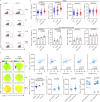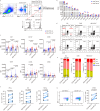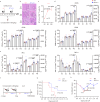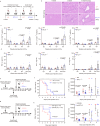BTLA contributes to acute-on-chronic liver failure infection and mortality through CD4+ T-cell exhaustion
- PMID: 38418488
- PMCID: PMC10901893
- DOI: 10.1038/s41467-024-46047-8
BTLA contributes to acute-on-chronic liver failure infection and mortality through CD4+ T-cell exhaustion
Abstract
B- and T-lymphocyte attenuator (BTLA) levels are increased in patients with hepatitis B virus-related acute-on-chronic liver failure (HBV-ACLF). This condition is characterized by susceptibility to infection and T-cell immune exhaustion. However, whether BTLA can induce T-cell immune exhaustion and increase the risk of infection remains unclear. Here, we report that BTLA levels are significantly increased in the circulating and intrahepatic CD4+ T cells from patients with HBV-ACLF, and are positively correlated with disease severity, prognosis, and infection complications. BTLA levels were upregulated by the IL-6 and TNF signaling pathways. Antibody crosslinking of BTLA activated the PI3K-Akt pathway to inhibit the activation, proliferation, and cytokine production of CD4+ T cells while promoting their apoptosis. In contrast, BTLA knockdown promoted their activation and proliferation. BTLA-/- ACLF mice exhibited increased cytokine secretion, and reduced mortality and bacterial burden. The administration of a neutralizing anti-BTLA antibody reduced Klebsiella pneumoniae load and mortality in mice with ACLF. These data may help elucidate HBV-ACLF pathogenesis and aid in identifying novel drug targets.
© 2024. The Author(s).
Conflict of interest statement
The authors declare no competing interests.
Figures








Similar articles
-
Hepatic expansion of virus-specific CD8+BTLA+ T cells with regulatory properties in chronic hepatitis B virus infection.Cell Immunol. 2017 Jan;311:36-45. doi: 10.1016/j.cellimm.2016.10.002. Epub 2016 Oct 6. Cell Immunol. 2017. PMID: 27743606
-
Clinical Significance of BTLA and HVEM Expression on Circulating CD4+ T and CD8+ T Cells in Chronic Hepatitis B Virus Infection.Viral Immunol. 2022 May;35(4):291-302. doi: 10.1089/vim.2021.0134. Epub 2022 Feb 22. Viral Immunol. 2022. PMID: 35196150
-
The intrahepatic expression and distribution of BTLA and its ligand HVEM in patients with HBV-related acute-on-chronic liver failure.Diagn Pathol. 2012 Oct 15;7:142. doi: 10.1186/1746-1596-7-142. Diagn Pathol. 2012. PMID: 23067542 Free PMC article.
-
BTLA/HVEM Signaling: Milestones in Research and Role in Chronic Hepatitis B Virus Infection.Front Immunol. 2019 Mar 29;10:617. doi: 10.3389/fimmu.2019.00617. eCollection 2019. Front Immunol. 2019. PMID: 30984188 Free PMC article. Review.
-
[Relationship between CD4+CD25+Treg cells, Th17 cells and IL-6 and the prognosis of hepatitis B virus-related acute-on-chronic liver failure: a meta-analysis].Zhonghua Gan Zang Bing Za Zhi. 2014 Jul;22(7):493-8. doi: 10.3760/cma.j.issn.1007-3418.2014.07.004. Zhonghua Gan Zang Bing Za Zhi. 2014. PMID: 25203799 Review. Chinese.
Cited by
-
Immunological Mechanisms and Effects of Bacterial Infections in Acute-on-Chronic Liver Failure.Cells. 2025 May 15;14(10):718. doi: 10.3390/cells14100718. Cells. 2025. PMID: 40422221 Free PMC article. Review.
-
Machine learning and bioinformatics analysis to identify and validate diagnostic model associated with immune infiltration in rheumatoid arthritis.Clin Rheumatol. 2025 Jul;44(7):2683-2694. doi: 10.1007/s10067-025-07514-9. Epub 2025 Jun 11. Clin Rheumatol. 2025. PMID: 40500570
-
CD45+ erythroid progenitor cells as potential biomarkers for disease progression in hepatitis B virus-related acute-on-chronic liver failure.BMC Gastroenterol. 2025 May 26;25(1):405. doi: 10.1186/s12876-025-03995-9. BMC Gastroenterol. 2025. PMID: 40419964 Free PMC article.
-
Targeting immune checkpoints in hepatocellular carcinoma therapy: toward combination strategies with curative potential.Exp Hematol Oncol. 2025 May 2;14(1):65. doi: 10.1186/s40164-025-00636-5. Exp Hematol Oncol. 2025. PMID: 40317077 Free PMC article. Review.
-
Association between early antibiotic treatment after admission and mortality of acute-on-chronic liver failure patients with bacterial infection: A multicenter retrospective study.Virulence. 2025 Dec;16(1):2509757. doi: 10.1080/21505594.2025.2509757. Epub 2025 May 29. Virulence. 2025. PMID: 40443157 Free PMC article.
References
MeSH terms
Substances
Grants and funding
- 82370604/National Natural Science Foundation of China (National Science Foundation of China)
- 82003864/National Natural Science Foundation of China (National Science Foundation of China)
- 81670528/National Natural Science Foundation of China (National Science Foundation of China)
- 81670528/National Natural Science Foundation of China (National Science Foundation of China)
- 2023J01239, 2019J01593/Natural Science Foundation of Fujian Province (Fujian Provincial Natural Science Foundation)
LinkOut - more resources
Full Text Sources
Molecular Biology Databases
Research Materials

